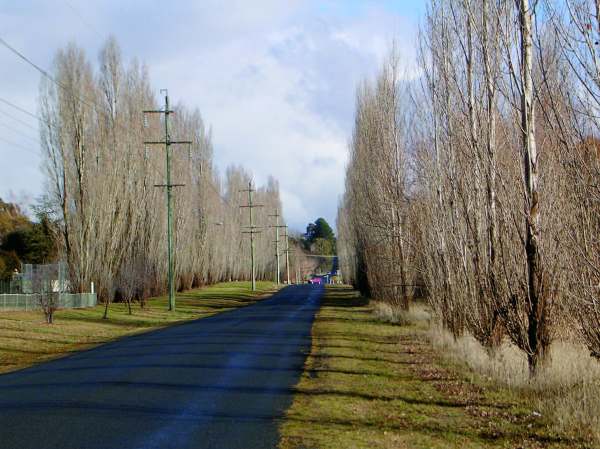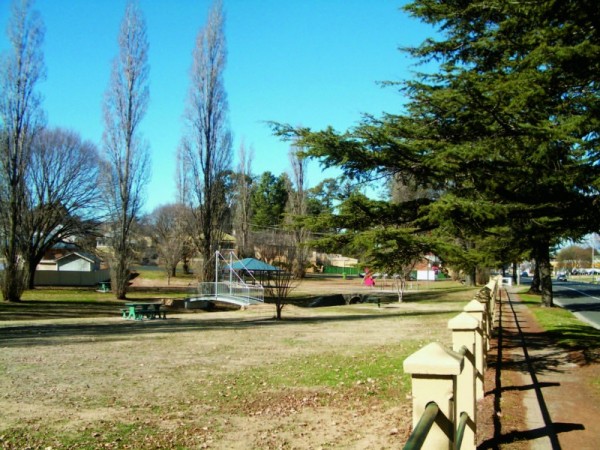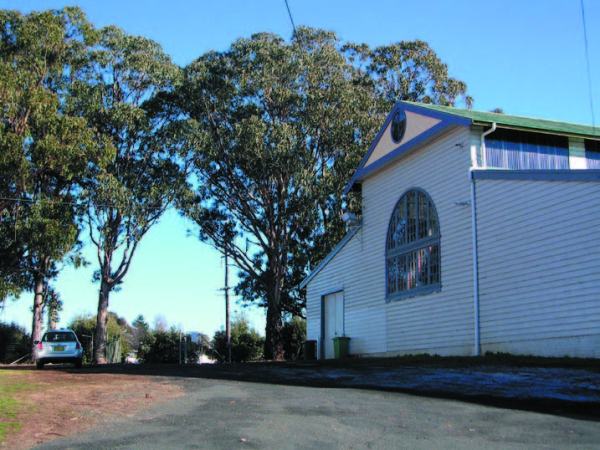Binya Pine located rear yard of Orange Fire Station Location Rear yard of Orange Fire Station, part of the Precinct of Central Orange. Tree Species Bunya Pine (Araucaria bidwillii) Physical Description Large trunked tree with a semi domed form. Tree is a healthy specimen with no signs of deterioration. Statement of Significance This Bunya Pine... Continue Reading →
Significant Trees: Lake Canobolas
Location Pinnacle Road (approximately 9 km west of Orange). Tree Species Radiata Pine (Pinus radiata) Cedar (Cedrus sp.) Physical Description The Cedars are spectacular trees easily recognisable with their conical form and bright yellow/green foliage. The broad canopies of the Cedars provide shade and visual amenity to visitors of the dam. The mature Radiata Pines... Continue Reading →
Significant Trees: Gateway Park
Location Mitchell Highway, approximately 3 km south east of the Orange CBD. Tree Species Lombardy Poplar (Populus nigra cv. ‘Italica’) Physical Description A lineal planting of Poplars, adjacent to the Mitchell Highway exhibit a narrow conical habit. The trees provide a changing feature entry to Orange: with their deep green foliage in summer, turning yellow... Continue Reading →
View from Gateway Park
View of Mount Canobolas and The Pinnacle from Gateway Park Location View from Gateway Park, Bathurst Road (Mitchell Highway). Statement of Significance View of Mount Canobolas and The Pinnacle from Gateway Park, as seen through the avenue of Lombardy Poplars. This view signifies the arrival into Orange City Centre and can only be appreciated in... Continue Reading →
Gateway Park
Location Mitchell Highway, approximately 3 km South East of the Orange CBD. Statement of Significance The linear planting pattern of the Lombardy Poplars at Gateway Park forms a distinctive landscape feature of the approach to Orange from Bathurst. The Poplars have been planted in a line, parallel to the road from which a sequence of... Continue Reading →
Clifton Grove
Location North East of Orange, located East of Ophir Road and North of Summer Hill Creek. Statement of Significance Clifton Grove is a rural residential subdivision which receives its name from the original homestead. Clifton Grove is significant as one of the first planned rural residential estates in NSW. The subdivision plan was given approval... Continue Reading →
Significant Trees: Ploughman’s Lane
Location Ploughman’s Lane (between The Escort Way and Canobolas Road), West of Orange. Tree Species Lombardy Poplar (Populus nigra cv. ‘Italica’). Physical Description Tall narrow trunked tree with numerous branches starting from ground level. Some examples of wind damage to western facing trees. Statement of Significance The poplars have an aesthetic significance for the strong... Continue Reading →
Ploughman’s Lane
Location Ploughman’s Lane (between The Escort Way and Canobolas Road), West of Orange. Statement of Significance Ploughman’s Lane has significance as a linear landscape that serves to divide suburban Orange in the East from the rural fringe in the West. The lane is framed on either side by an avenue of Poplars. Contrasts of landscape... Continue Reading →
Significant Trees: Sir Jack Brabham Park and Bloomfield Hospital
Location Boundary of Sir Jack Brabham Park and Bloomfield Hospital. Tree Species Lombardy Poplar (Populus nigra cv. ‘Italica’) Radiata Pine (Pinus radiata) Physical Description A mature row of Radiata Pines dominate the boundary of Bloomfield Hospital and Jack Brabham Park. In Summer the green foliage of the Poplars blend which in with plantings of Radiata... Continue Reading →
Sir Jack Brabham Park and Bloomfield Hospital
The boundary between Jack Brabham Park and Bloomfield Hospital is planted with Pinus radiata and Populus nigra var italica Location Forest Road (between Huntley Road and Bloomfield Road). Statement of Significance Located on the Southern edge of the city, the landscape of this precinct includes historically, aesthetically and socially significant places. The institutional landscape of... Continue Reading →
Residential Trees: Glenroi
Location Endsleigh House, Endsleigh Avenue, part of the Precinct of Glenroi. Tree Species Cedar (Cedrus sp.) Conifer (Chamaecyparis sp.) Physical Description The historic homestead of Endsleigh House is characterised by a mixed planting of Conifers. The bright yellow/green foliage of the Chamaecyparis contrasts with that of the deciduous Cedar located in the front yard. Residential... Continue Reading →
Significant Trees: Memory Park
Location Memory Park. Icely Road and Bathurst Road. Tree Species Lombardy Poplar (Populus nigra cv. ‘Italica’) Physical Description Healthy mature specimens with tall trunks and many branches from the ground up. Trees create a ‘soldier’ effect of straight lines. Statement of Significance The Poplars were planted beginning in 1935 for each former Mayor of Orange... Continue Reading →
Memory Park
The memorial poplars of Memory Park are at left and the cedars of the Memorial Avenue plantings are at right Location Icely Road and Bathurst Road. Statement of Significance Memory Park formed part of town planner Norman Weekes’ concept developed during the 1920s aimed at enhancing the entry points to Orange. Weekes’ original gateway concept... Continue Reading →
Orange Showground
Location Leeds Parade, approximately 2 km North East of the Orange CBD. Statement of Significance Located toward the North Eastern outskirts of town, the Showground has been an important site for the agricultural and social life of the town since it was developed in 1908. The entry gate is flanked by mature remnant Eucalypts, and... Continue Reading →
Views of Windbreaks
Location Windbreaks, generally located throughout the Local Government Area but predominantly on the elevated plateau to the South. Statement of Significance Windbreaks are a characteristic feature of the rural lands within Orange City, they are particularly prevalent in the Southern areas of the city on the elevated plateau. The lack of relief in landform on... Continue Reading →
Place: Cook Park
Location Summer Street, between Clinton and Sampson Streets, part of the Precinct of Central Orange. Statement of Significance The area that is now Cook Park was proclaimed in 1873, with the name Cook Park applied in 1882 and planting begun in about 1890. It represents an excellent example of High Victorian park design in the... Continue Reading →
















